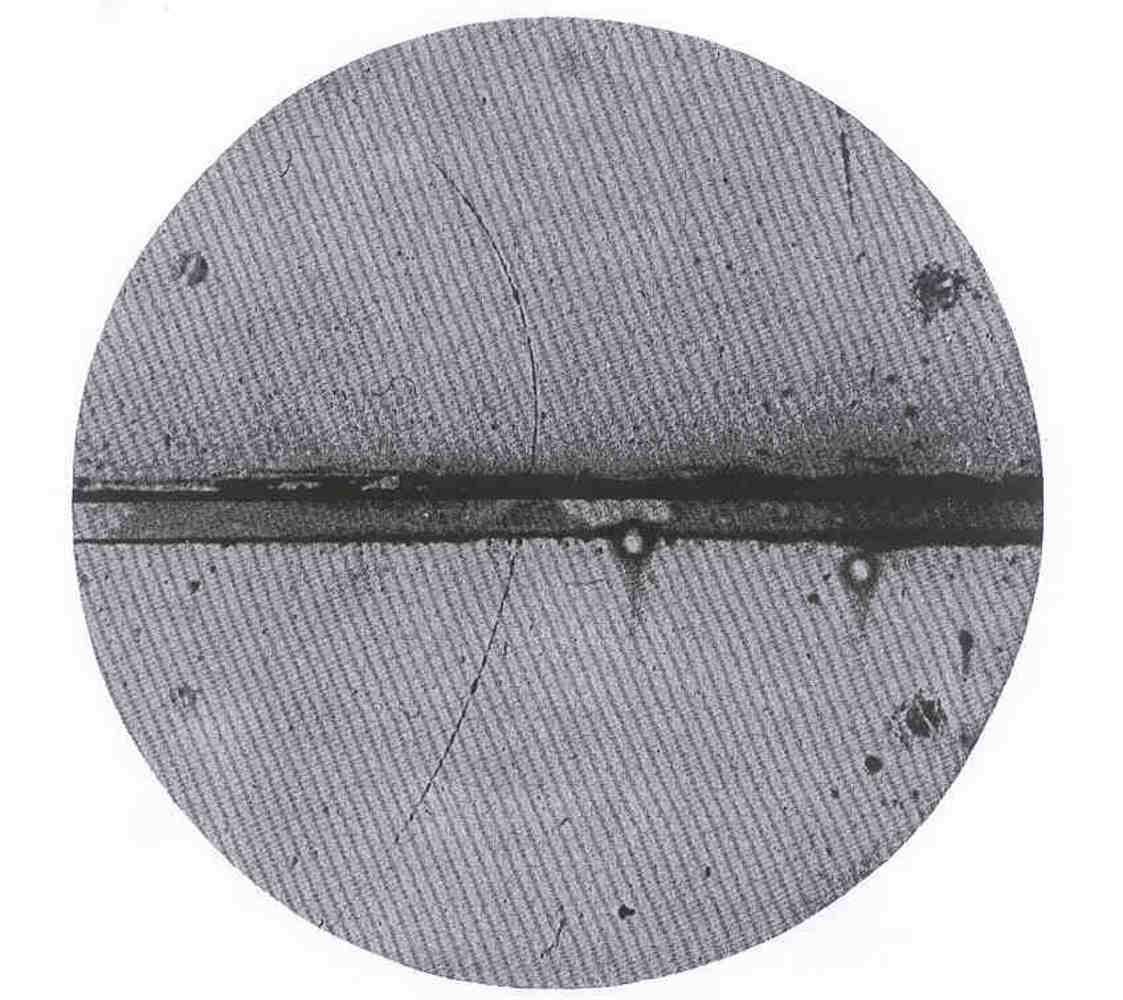Amongst the many gifts physics has presented to science fiction, antimatter is doubtless a highly prized one. It has a catchy name; it is very mysterious and it can 'annihilate' things (and thus be used as a murder weapon, according to Dan Brown). Yet, to physicists, antimatter is somewhat less than exciting and would be almost mundane if it wasn't for one shocking truth about it: it seems to have entirely vanished from our Universe!
It was in the late 1920's that theoretical physicist Paul Dirac, working in Cambridge,  predicted the existence of antimatter. Quantum mechanics was the talk of the town (or at least the university) and Dirac was working on it.
predicted the existence of antimatter. Quantum mechanics was the talk of the town (or at least the university) and Dirac was working on it.
He was trying to incorporate relativity, itself only 20 years old, into a quantum description of the electron. The equations seemed only to say that it was impossible for the electron to obey the laws of both theories. That is, unless it was assumed, and without any experimental evidence, that there existed a new particle, identical to the electron in every respect apart from its electric charge. There simply had to exist an "anti-electron".
It might have been a great mathematical way to fix the equations, but there was something truly ludicrous about this idea. The electron had been detected more than thirty years earlier. If you wanted to study it, finding it was not exactly difficult: it was more or less everywhere. If a particle existed that was identical to it but with the opposite electric charge, then it should have been equally easy to detect. So where was it? In what is now considered as a stroke of genius, Dirac went ahead despite this issue, and proclaimed the anti-electron existed. Now it was up to an experimental physicists to find it...
Amazingly enough, it only took two years for one of them to do just that. In 1933,  Carl Anderson, of the California Institute of Technology, discovered the elusive particle. Although, as would have been plain to Dirac, anti-electrons are not commonly found on Earth, they do fall on our heads from the sky. In fact, we now know that numerous and various energetic particles are constantly zooming around the Universe. Inevitably, some end up passing through our planet's atmosphere; these, together with the cascade of particles their passage can produce, form what we call cosmic rays. Unknown to Dirac was that cosmic rays do include anti-electrons, which is what Anderson observed. Turning his apparatus heavenwards, he photographed something that would have been inconceivable just a few years earlier - the passage of positively charged "electrons".
Carl Anderson, of the California Institute of Technology, discovered the elusive particle. Although, as would have been plain to Dirac, anti-electrons are not commonly found on Earth, they do fall on our heads from the sky. In fact, we now know that numerous and various energetic particles are constantly zooming around the Universe. Inevitably, some end up passing through our planet's atmosphere; these, together with the cascade of particles their passage can produce, form what we call cosmic rays. Unknown to Dirac was that cosmic rays do include anti-electrons, which is what Anderson observed. Turning his apparatus heavenwards, he photographed something that would have been inconceivable just a few years earlier - the passage of positively charged "electrons".
Mirror images
This was certainly great news for Dirac and great news for physics itself: it enabled a quantum relativistic description of matter. Since then a model of all the known elementary particles has been built. In this "Standard Model", each particle has a corresponding antiparticle. Both are identical in all their properties such as the mass and spin, but they have opposite electric charges.
The Standard Model treats particles and antiparticles very much on an equal footing, and this reflects observed behaviour. Collisions in particle accelerators, for instance, routinely produce antiparticle and particle pairs, and even "anti-atoms" of anti-hydrogen were demonstrated at CERN in 1995.
In fact, there really is nothing exceptional, or indeed exciting, about antimatter - if you were to watch a film set in an anti-world, where anti-people have anti-houses and drink anti-tea, you wouldn't see any obvious difference with the "ordinary" world. But when a particle and its corresponding antiparticle meet, however, something exciting does happen: they both vanish in a flash of light (you might want to keep this in mind if ever the anti-people invite you over for an anti-cuppa).
For this reason, keeping antimatter for any length of time is exceedingly difficult - making sure antimatter doesn't come into contact with matter at all is a real experimental challenge. At CERN, charged antiparticles are maintained in ultra high vacuum jars using magnetic and electric fields. No one has yet found a way of containing electrically neutral antiparticles.
Matter and antimatter are in fact so similar that physicists sometimes describe them as the mirror images of one another. Departures from this matter-antimatter symmetry have been observed, but they are very small. There is a rare particle, called the kaon, which turns into other particles at a slightly different rate than the anti-kaon turns into the corresponding antiparticles. A handful of other exotic particles closely related to the kaon have a similar behaviour. Considering it is so very rare, it does seem a bit odd that this behaviour should be possible at all.  It has, however, been incorporated in the Standard Model quite smoothly, and without altering the general picture of antimatter.
It has, however, been incorporated in the Standard Model quite smoothly, and without altering the general picture of antimatter.
Evil twins
That said, and as we all know, there is an essential difference between matter and anti-matter, something that was already clear to Dirac in the 20s: there are no anti-electrons on Earth, let alone anti-people, anti-tables or anti-books. In fact, there is no evidence of there being any sizeable "lumps" of antimatter anywhere in the observable Universe. Antiparticles observed in cosmic rays, like Anderson's anti-electrons, are in large part what physicists call secondary; this means that they have been created by the interaction of another particle (here of ordinary matter) with either some interstellar medium or our own atmosphere - both made of matter. Critically, they don't seem to come from some distant "source" of antimatter.
Moreover, the antimatter CERN uses hasn't been harvested; instead it had to be created through collisions between ordinary protons and nuclei. One possible outcome of such collisions is the simultaneous production of a proton and anti-proton, known as "pair production". As they have opposite charges, the two species can be prevented from annihilating one another by driving them apart with a strong magnetic field; then the anti-protons can be collected.
Cosy as this sounds, it still leaves a yawning hole in the argument. On the one hand, the current laws of physics seem to preclude any significant difference between matter and antimatter. On the other hand, there clearly is a major difference between matter and antimatter. In fact, the puzzle is even deeper.
The early Universe was a much smaller, denser and hotter place than it is today. In such an environment, collisions (and therefore reactions) between particles happened at an incredibly fast rate. If, in those early moments, matter and antimatter had been, unlike today, present in equal quantities, then something terrible would have happened. Protons and anti-protons would have annihilated, electrons and anti-electrons would have annihilated... there would be virtually nothing left in the Universe! If our Standard Model is to be believed, there can only be something in the Universe today if there never existed any significant amount of antimatter. The Big Bang would need to have generated matter only, and no antimatter whatsoever. The fact that our nearly matter-antimatter-symmetric model should lead to this "annihilation catastrophe" is a major issue in modern physics.
A forensic investigation into outer space
It was unlikely that such a puzzling case would not attract the attention of a large number of (mainly) theoretical physicists. Over the years, it has become clear that there really are only three possible solutions to this issue:
1) We assume that the Big Bang didn't produce any antimatter, so that there has never been any significant amount of antimatter in the Universe.
2) We assume that the Big Bang produced matter and antimatter in equal proportions, and that they still exist in equal proportion; it's just that we live in an immense "matter region" of the Universe, and there are no 'antimatter regions' close enough for us to observe them.
3) We assume that the Big Bang produced matter and antimatter in equal proportions, and that there really isn't any antimatter left; something happened to the antimatter earlier, though our model can't explain it.
Today's physicists are favouring the third option. The first "answer" is considered by many to be unsatisfactory; by merely stating that the Universe started off without antimatter, it is felt it avoids the issue. The second option might be a possibility, though explaining how matter and antimatter ended up segregated on such a scale is no simple task.
But the third set of assumptions forces physicists to look for a mechanism that would effectively create a net amount of matter. Maybe an unknown reaction exists that favours production of an electron than an anti-electron, or a reaction that destroys an anti-proton more often than the opposite reaction destroys a proton? Or perhaps a complicated chain of interactions like this takes place?
For a time there was hope that the peculiar interaction of the kaon might have happened often enough in the early Universe to  explain what we see today. Unfortunately, it seems it was much too uncommon even in the hot, dense first moments of time.
explain what we see today. Unfortunately, it seems it was much too uncommon even in the hot, dense first moments of time.
Instead, having taken a leaf from Dirac's book, many physicists now believe that as yet unknown particles may lie at the heart of the "antimatter whodunnit" case. These particles, they suspect, existed only in the early Universe and now cannot be found in nature because they have since decayed into the more common proton, neutron and electron.
This sounds like an insurmountable conundrum, but even if these particles no longer exist in the real world, maybe they can be re-created, and CERN's Large Hadron Collider is attempting to do just this.
Though none of these particles might end up being the main suspect, it can be hoped that they will help shed a little more light on the strange case of the annihilation catastrophy. Whatever comes out of the collisions there should prove inspiring to physicists... and to science fiction writers too!
- Previous Balls, Tits and Fannies
- Next What is Love?









Comments
Add a comment